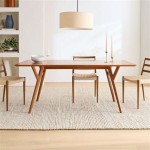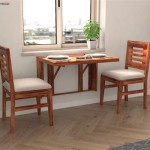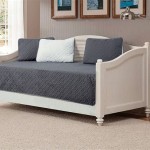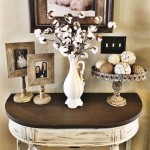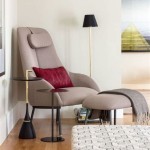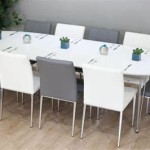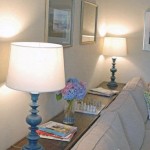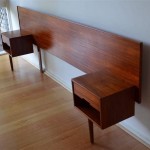Mid Century Modern Solid Wood Coffee Tables: A Study in Timeless Design and Functionality
Mid-Century Modern (MCM) design, an aesthetic movement that flourished from the mid-1940s to the 1960s, continues to exert a profound influence on contemporary interior design. At the heart of this enduring appeal is a commitment to clean lines, organic shapes, and a functional approach to form. Among the defining pieces of MCM furniture, the solid wood coffee table stands out as a versatile and visually striking element, embodying the era's core principles.
These tables are more than just decorative objects; they serve as focal points in living spaces, providing a surface for everyday items, showcasing personal style, and facilitating social interaction. The use of solid wood, a hallmark of MCM craftsmanship, contributes to the tables' durability, warmth, and inherent beauty. This article explores the key characteristics, design elements, materials, and enduring appeal of mid-century modern solid wood coffee tables.
The Key Characteristics of Mid-Century Modern Coffee Tables
Several defining characteristics differentiate mid-century modern coffee tables from other furniture styles. Understanding these elements is crucial for identifying genuine MCM pieces and appreciating their aesthetic value.
Firstly, simplicity and minimalism are paramount. MCM coffee tables eschew excessive ornamentation and intricate details. The focus remains on clean lines, geometric shapes, and an unadorned surface. This minimalist approach allows the natural beauty of the wood to take center stage.
Secondly, functionality is integrated seamlessly into the design. These tables are not merely decorative; they are designed to serve a practical purpose. They provide ample surface space for holding drinks, books, remotes, and other everyday essentials. Some designs also incorporate lower shelves or drawers for additional storage, further enhancing their utility.
Thirdly, the use of organic shapes and geometric forms is a prominent feature. While straight lines and right angles are common, many MCM coffee tables also incorporate curved edges, rounded corners, and tapered legs. These organic shapes soften the overall appearance and create a sense of visual harmony. Common geometric shapes include rectangles, squares, ovals, and even freeform designs that emulate natural forms.
Finally, the emphasis on quality craftsmanship and durable materials contributes to the longevity and value of these tables. Solid wood, being the primary construction material, provides exceptional strength and stability. Mortise-and-tenon joinery, dovetail drawers, and other traditional woodworking techniques ensure that these tables can withstand the test of time.
Design Elements and Variations
Within the broader category of mid-century modern solid wood coffee tables, a diverse range of design elements and variations exists. These variations reflect the creativity and innovation of designers during the mid-century era.
One common design element is the use of tapered legs. These legs, which are typically angled outwards, create a sense of lightness and visual interest. They are often made of solid wood and may be stained or finished to match the tabletop. Alternatively, some designs feature metal legs, which provide a contrasting texture and a more industrial aesthetic. Metal legs were often brass or chrome plated adding to the overall sleekness.
Another popular variation is the incorporation of a lower shelf. This shelf provides additional storage space for magazines, books, or decorative items. It also adds another layer of visual interest to the table's design. The shelf may be made of solid wood, veneer, or even woven cane, depending on the specific design.
Floating tops, where the tabletop appears to hover above the base, are also frequently seen. This design element creates a sense of airiness and sophistication. The tabletop is typically attached to the base using a concealed support system, making the connection virtually invisible. The illusion creates a focal point that enhances the overall aesthetic.
Furthermore, some MCM coffee tables feature built-in storage compartments or drawers. These compartments provide a convenient way to conceal clutter and keep the living space organized. The drawers are often integrated seamlessly into the table's design, maintaining the clean lines and minimalist aesthetic.
Finally, the shape and size of the tabletop can vary significantly. Rectangular coffee tables are the most common, but square, oval, and round tables are also available. The size of the table should be proportionate to the size of the living room and the seating arrangement. A larger living room can accommodate a larger coffee table, while a smaller space may require a more compact design. The overall size is dependent on both form and function within a well-designed space.
Materials and Construction Techniques
The choice of materials and construction techniques is critical to the quality and durability of mid-century modern solid wood coffee tables. The use of solid wood is a defining characteristic, but the specific type of wood and the joinery methods employed can vary.
Solid hardwoods, such as walnut, teak, maple, and oak, were commonly used in the construction of MCM coffee tables. These woods are known for their strength, durability, and distinctive grain patterns. Walnut, in particular, was highly prized for its rich color and elegant appearance. Teak, with its natural resistance to moisture and decay, was often used in outdoor or patio furniture.
Veneer was also used in some MCM coffee tables, typically as a surface layer over a core of less expensive solid wood or plywood. Veneer allowed designers to achieve a consistent grain pattern and a more luxurious appearance without incurring the cost of using solid hardwood throughout. However, high-quality veneer was carefully selected and applied to ensure durability and prevent warping or cracking.
The joinery methods used in constructing MCM coffee tables were typically traditional woodworking techniques, such as mortise-and-tenon joints, dovetail joints, and dado joints. These joints provide exceptional strength and stability, ensuring that the table can withstand years of use. Mortise-and-tenon joints, in particular, are known for their ability to resist racking and twisting forces.
The finishing process is also crucial to the overall appearance and durability of the coffee table. A clear lacquer or varnish finish was typically applied to protect the wood and enhance its natural beauty. The finish also provides a smooth, easy-to-clean surface. The lacquers used were often matte or satin, allowing the natural grain of the wood to be seen through the finish.
Metal elements, such as legs and hardware, were often made of steel or brass. Steel legs were typically powder-coated or chrome-plated for durability and corrosion resistance. Brass hardware, such as drawer pulls and knobs, added a touch of elegance and sophistication.
The Enduring Appeal of Mid-Century Modern Coffee Tables
The continued popularity of mid-century modern solid wood coffee tables is a testament to their timeless design and enduring appeal. Several factors contribute to their enduring appeal.
Firstly, the minimalist aesthetic of MCM furniture complements a wide range of interior design styles. Whether the home is decorated in a traditional, contemporary, or eclectic style, a mid-century modern coffee table can seamlessly integrate into the existing décor. Its clean lines and simple forms provide a sense of visual harmony and balance.
Secondly, the functional design of these tables makes them practical and versatile. They provide ample surface space for everyday items, while also serving as a focal point in the living room. The addition of shelves or drawers further enhances their utility. Their thoughtful design ensures they are both aesthetically pleasing and practically useful.
Thirdly, the quality craftsmanship and durable materials used in their construction ensure that these tables can last for generations. Solid wood, combined with traditional woodworking techniques, creates a piece of furniture that is both beautiful and long-lasting. This durability makes them a worthwhile investment for homeowners who value quality and longevity.
Finally, the historical significance of mid-century modern design adds to its appeal. MCM furniture represents a specific era of innovation and creativity in design. Owning a piece of MCM furniture allows homeowners to connect with this history and appreciate the ingenuity of the designers who created these iconic pieces. The historical context adds depth and meaning to the furniture, making it more than just a functional object.
In conclusion, the mid-century modern solid wood coffee table exemplifies the principles of good design: form, function, and enduring quality. Its simple lines, organic shapes, and durable construction make it a timeless piece of furniture that continues to be appreciated by homeowners around the world. These tables are more than just furniture, they are statements of style and expressions of a love for well-crafted objects.

Florence Mid Century Solid Wood Coffee Table Midinmod Tx

Welwick Designs 48 In Caramel Rectangle Solid Wood Mid Century Modern Storage Coffee Table With 3 Drawers Hd9538 The Home

Mid Century Coffee Table Solid Wood Rectangle Etsy

Dane Mid Century Modern Rectangular Solid Wood Coffee Table In Brown Ebay
Chadwick Coffee Table

Connor Mid Century Modern Rectangular Solid Wood Coffee Table In Brown Bushfurniturecollection Com

Coffee Table In Solid Wood Mid Century Etsy

Welwick Designs 48 In Caramel Rectangle Solid Wood Mid Century Modern Storage Coffee Table With 3 Drawers Hd9538 The Home

Mid Century Solid Walnut Wood Coffee Table Open Door Furniture

36 Mid Century Modern Coffee Tables That Steal Centre Stage

